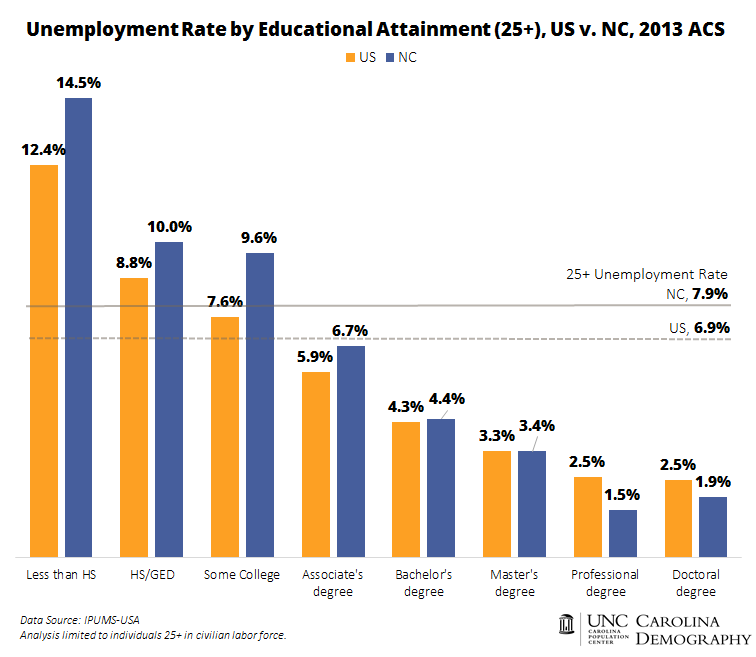Educational Attainment and Unemployment
The Bureau of Labor Statistics regularly publishes national unemployment rates by educational attainment for the highest degree attained for workers 25 and older. This analysis typically uses the Current Population Survey (CPS) data. Unfortunately, the CPS data are too small to provide high quality estimates for unemployment rates by educational attainment for individual states. Thankfully, there are multiple federal sources of statistical information available. The large sample size of the U.S. Census Bureau’s annual American Community Survey allows us to examine differences in unemployment by educational attainment at the state level. (Keep in mind that the ACS and CPS estimates will differ due to differences in how the sample is constructed and collected.)
In 2013, North Carolina’s unemployment rate for all civilian workers ages 25 and older was 7.9%, higher than the national unemployment rate of 6.9%. These rates were highest among workers without a high school diploma. Nearly 15% of North Carolina workers without a high school diploma were unemployed in 2013, as were 12.4% nationwide. As educational attainment increases, the unemployment rate steadily drops. Although workers with some college but no degree had lower unemployment rates at the national level (7.6% vs. 8.8%), the differences were not as pronounced in North Carolina (9.6% vs. 10%).
The lowest levels of unemployment were seen among individuals with professional degrees (MD, JD, MBA) and doctoral degrees. In North Carolina, fewer than 2% of adult workers 25 and older with these degrees were unemployed in 2013. This was slightly less than the national rate of 2.5% for these groups.
Regardless of the postsecondary diploma held—whether associate’s degree, bachelor’s, master’s, or more—unemployment rates were lower for individuals with some form of postsecondary diploma when compared with overall unemployment rates in 2013.
Unemployment by Education & Age
We see similar unemployment patterns by educational attainment and age group.
Unemployment rates decline steadily across age groups. Nearly 10% of North Carolina workers between the ages of 25-34 were unemployed in 2013, compared to 7.8% of workers 35-44, 7.6% of workers 45-54, 6.8% of workers 55-64, and 5.9% of workers 65 and older.
Of course, these unemployment differentials by age may reflect age differences in labor force participation. Younger individuals are much more likely to be in the labor force than older ones. Over 82% of individuals 25-44 are in the labor force compared to 16% of individuals 65 and over. This suggests that individuals at older ages who are unable to find work may instead leave the labor force altogether, choosing retirement over unemployment.
Within each age group, individuals with higher educational attainment are much more likely to be in the labor force. Ninety-four percent of workers ages 25-34 with a professional or doctoral degree were in the labor force in 2013 compared to 66% of individuals without a high school diploma. Among workers 65 and older, 37% with a professional or doctoral degree were still working in 2013 compared to only 9% of those with less than a high school diploma.
At all ages, individuals with higher educational attainment are not only more likely to be in the labor force, they are less likely to be unemployed. Individuals without a high school diploma had the highest unemployment rates among all age groups, ranging from a high of 19% unemployed among 25-34 year-olds without a high school diploma to 9% of individuals 65 and older without a high school diploma.
Unemployment rates for individuals with a bachelor’s degree or more were far below their age group average unemployment rate. And individuals with a professional or doctoral degree had the lowest unemployment rates for all age groups in 2013.
Note: Professional degrees and doctoral degrees were combined for the analysis of educational attainment and unemployment rate by age to improve overall sample size. All data were downloaded from IPUMS-USA.
Your support is critical to our mission of measuring, understanding, and predicting population change and its impact. Donate to Carolina Demography today.